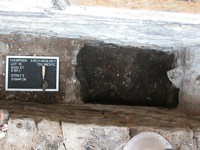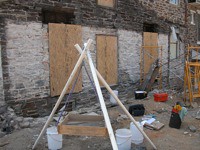Thanks everyone for all of your comments. I enjoyed the tour. There are a lot of questions here, so I will try to take them one at a time.
The most common thing that folks commented about was the idea of a microcosm. In some ways I think that this is a useful way to think about the neighborhood, but in others I think that it is not. Here is why:
Hampden, like many other industrial towns was, as we discussed, closely tied to the Atlantic economy through the shipping industry. Because of this, it was subject to the same ideological and economic forces - including market pressures, organized labor activities, paternalism, and so forth – that it followed the same general historical/economic trajectory as many other places in America.
With that said, its important to bring up something we didn’t get a chance to talk about on the tour, which is Hampden’s history of racial exclusion and outright racism. Cady is correct when she points out that:
There are parts of America that weren't represented in Hampden during that time that were keys parts of the country.
In fact, there were large parts of American that aren’t represented in Hampden’s history. In particular, one reason that the paternalist system worked is that the mill workers, who were almost exclusively people of English descent that migrated from the Appalacians to the town in search of steady work, exchanged their good behavior for favorable hiring practices. Those practices excluded anyone of African or Eastern European descent from working in the mills. This legacy of exclusion has had lasting consequences, and even today the neighborhood of Hampden is 92% “white” (according to the 2000 U.S. census) in a city that is at least 70% African-American.
Another common question concerned Hampden’s future. People wanted to know if I thought Hampden would continue to gentrify, and what I though the next ten to twenty years would be like. I have to say that I don’t know. There is a lot of struggle along class lines in Hampden right now, and the direction of Hampden’s future depends in large part on the outcomes of those struggles. I think that development in Hampden will probably continue until houses get too expensive for people to buy, and then it will slow down or stop.
Some of you wondered about the effect this would have on working-class families in Hampden. The goal of my project is to give working-class families in Hampden a voice in how development occurs in their neighborhood by giving them a concrete and powerful way to talk about their heritage. If all goes well for working families in Hampden, they will continue to wield some control over the processes of development and gentrification in
Some others:
Since the mills have been shut down and the silver company is no longer, what other businesses provide an income to this town? Also, what is your favorite part of Hampden?Hampden has gone through a number of economic changes in the last century. The mills, along with other manufacturing operations, left slowly, beginning in the 1920’s. By the late 1960’s the major textile mills had moved south in search of cheaper labor. As all of this occurred, the people who worked in manufacturing were forced to look outside of the neighborhood for jobs, sometimes with limited success. By the 1970’s, Hampden was a fairly impoverished, fairly unsafe neighborhood. Even the commercial sector – the small business owners- began to suffer, and many shops in the neighborhood closed. When a resurgence began in the late 1980’s, it was not Hampdenites that started it, but middle-class entrepreneurs from outside of the neighborhood who sought to capitalize on cheap rents and working-class culture
When did the sort of "demise" of Hampden really start to occur? You mentioned how the police station left and crime went up, but i'm wondering if there were any other things that lead to this?I think its premature to announce the death of Hampden, but see my comments above. The social situation in any neighborhood is closely related to its economic structure, so that the rise in crime and poverty coincides with the economic changes that the neighborhood has undergone.
I'd like to learn more about life in the mill, where can I find more information? There aren’t a whole lot of sources, but check out these:
Hare, Jean.
1976 Hampden Woodberry. Hampden-Woodberry Community Council, Baltimore.
Harvey, William
1988 “The People is Grass”: a History of Hampden Woodberry 1802-1945. Della Press, Baltimore.
Hollyday, Guy
1994 Stone Hill: The People and Their Stories. Privately published, Baltimore.
All of these are available at the
Hampden branch of the Pratt on Falls Road
I realize the mills and the silverware company and the old police station are landmarks in the area, but what makes this area more famous and historic than any other? I don’t think about Hampden as being particularly famous. It is however quite historic, but I don’t think that it is more so than lots of other areas of Baltimore. It sounds like your asking why I should bother working here, and why you should bother learning about it. The answer there is that Hampden is a place that presents a wonderful combination of and contemporary historical problems, that I have the opportunity to study in detail. What I like about Hampden is not that its famous, but that there is a great deal of evidence – archaeological and historical – that tells us about people who couldn’t or didn’t write their own history. We know that most often, histories are written by the wealthy and powerful, who are never in the majority, and that those histories tend to reflect the interests of their authors. In contrast, I think its worthwhile to examine the pasts of people whose voices has been left out of those privileged histories.



